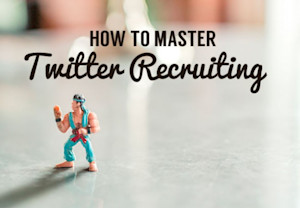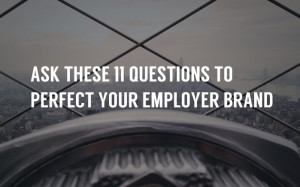It may not be as massive as Facebook, but there’s no denying that Twitter is a fantastic social recruiting platform.
Twitter has 250 million active users.
Twitter ranks second after Facebook as job seekers favourite social network.
45% of job seekers use Twitter as a major part of their job search.
8 million Americans have found a job using Twitter.
Numbers aside, Twitter is the only network out of the big three that allows you to directly engage with users that you don’t already have a relationship with. In fact, Twitter chats encourage and facilitate complete strangers to come together, connect, and engage in discussion on topics of mutual interest. Engaging on Twitter is also more casual and unobtrusive than a cold call or email. If your company has a Twitter account but isn’t leveraging the social network for your recruitment process, then this article is for you!
1 - Start With a Strong Brand
Select your Twitter profile photo and header image work together to convey your employer brand to potential candidates. Your profile photo should either be your company logo or if you are tweeting as yourself, a flattering and friendly headshot.
If you have a more casual brand you can even use a fun graphic to inject a little personality and humour into your profile, such as the martini glass used by the lovely Sharlyn Lauby of @HR_Bartender.
Use a high-resolution header image (1500 by 500 pixels) and represent your brand well. You can use photos of your offices, employees or something unique to you that shows off your personality.
2 - Perfect Your Bio
Your Twitter bio is a 160 character summary of who you are and what your Twitter account is all about. Being descriptive with your bio is critical because when you first engage with someone on Twitter your bio is the first thing that they’ll turn to in order to figure out who you are. State upfront what you do or what your company does and that you are looking to hire awesome people. Inject a little fun with some personal info and humour. If your bio makes candidates crack a smile, then you’re winning at Twitter already!
3 – Put Your Audience First
Always keep your target audience in mind. Your tone, branding, and content should all be tailored specifically to appeal to your ideal talent pool. If your audience is straight-laced, then keep your tweets professional. If you want quirky candidates, then be quirky. And if the talent you seek has a penchant for football, then by all means tweet about football! Which brings me to my next point:
4 - Post ALL the Things!
Okay… So I don’t actually want you to post everything, more like a good mix of engaging content. Tweet your open jobs, Tweet about Sarah from accounting’s latest marathon, share links to articles about finding jobs, share blog posts related to your field, and make sure to post lots of photos and video. Mixed content is more engaging and will grow your reach far more than only posting jobs as job posts don’t receive the same levels of shares as other types of content. Tweets using a picture are 94% more likely to be retweeted! – Click to Tweet And 92% of all Twitter interactions occur when readers click links.
5 – Hashtags Are Your BFF
Including relevant hashtags with your Tweets is the best way to get your content discovered and shared by fellow Tweeter. According to Buffer, brands can see a 50% increase in engagement by using hashtags and individuals can see as much as a 100% increase. When you tweet a job post some hashtags worth including are the location, the job title, the job field, #hiring, and #jobs (in the relevant language, of course!) You can use apps like Buzzsumo to see what hashtags are trending amongst your followers and use that to help you choose what hashtags to use, just make sure that you only use hashtags that are relevant to what you are tweeting or you will confuse people. Lastly, less is more with hashtags so don’t go overboard or people get annoyed. 1 - 2 hashtags is perfect, 3 – 5 is pushing it, and anything more than that is just plain offensive and will most likely decrease engagement with your post. More about which hashtags are best and how many you should use.
6 – Build Your Foundation
The more people that see your job postings, the better your chances of connecting with top talent. Building up your Twitter audience means getting more eyes on your job posts and the content you share. This article by Mashable will give you all the info you need to grow your Twitter community.
7 – Participation is 90% of Your Grade
Follow back, retweet, reply, join chats, and say thank you! You wouldn’t be very popular at a dinner party if you spent the entire evening shouting out recommendations, proclaiming your opinion without ever actually engaging with the other guests. The same goes for Twitter. Following back, retweeting other people's content, and thanking fellow tweeters for sharing your content is just as important as the content you choose to share. Replying to DMs and comments is how you foster engagement, and it’s just plain polite. And joining Twitter chats is probably the best possible way to meet and engage with new people who share similar interests. To start, I highly recommend joining in on #TChat. Here’s a guide to finding, joining and starting Twitter chats.
7.1 – Don’t Be a Bot
Unless you have developed some sort of ground breaking technology with which I am not familiar, then there is a person, or perhaps even multiple people behind your Twitter account. Use this to your benefit by letting the human shine through the technology. People want to interact with other people, they want to be able to relate and connect to the person behind the tweet, so let them. Share the occasional joke, laugh about your mistakes, and inject personality into your tweets. In short, be more than a robot! Want to learn more about how Jobcast can help your Twitter recruiting? Shoot us an email team@jobcast.net or try Jobcast Premium free for 30 days :D
Read More




